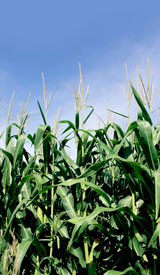February 14, 2008
Contact: Jon Greenwood, Canton, 315-386-3231; Joe Giroux, Plattsburgh,
518-563-7523; R. David Smith, Cornell University, 607-255-7286
Which Corn to Plant in 2008?
NNY Farm Research Provides Data for Critical Decision
Northern New York farmers plant more than 120,000 acres of corn for
harvesting as grain and silage to feed livestock. As ethanol production
creates demand for corn as a fuel source that acreage will likely
increase. The variety of corn a farmer chooses to grow affects the
success of the crop and its intended use. The Northern New York
Agricultural Development Program funds annual corn variety trials that
provide farmers with data for that making that critical decision. The
Program has just released its corn grain variety evaluation results for
2008. Fact sheets with the results of the corn grain and corn silage
evaluations for 2008 decision-making are posted on the Northern New York
Agricultural Development Program website at www.nnyagdev.org.
Northern New York Agricultural Development Program Co-Chair Jon
Greenwood says, �The farmers on the Northern New York Agricultural
Development Program committee have set as priorities for 2008 evaluating
appropriate hybrids for growing corn for grain under our regional
conditions and assessing their suitability for sale to ethanol
producers.�
�Grain yield and starch content data are two comparative factors that
can be used to assess the potential ethanol productivity of varieties
for this new corn market,� says Dr. Margaret E. Smith of Cornell
University�s Department of Plant Breeding and Genetics. Smith leads the
corn grain hybrid testing program for Northern New York.
Ron Robbins hosts annual corn variety trials at his farm in Sackets
Harbor. He says, �These trials provide data on several crop factors �
from moisture and starch content to how well the corn stands on its
stalk and how well it withstands the weather. In 2007, we had a drought
here in western Northern New York that started in July and lasted
through the summer. The trial yields here ranged from 136 to 207 bushels
per acre. Clearly, the variety of corn hybrid you choose to plant can
affect how much you harvest and the quality of that harvest. This
research is critical for the profitability of Northern New York farms.�
Robbins says he compares the data for the trials on his farm with the
data for trials at Greenwood�s dairy farm in St. Lawrence County and at
the W.H. Miner Agricultural Research Institute in Chazy, Clinton County.
�The growing conditions across Northern New York�s six counties
(Jefferson, St. Lawrence, Lewis, Franklin, Clinton and Essex) create
significant differences for producing corn. I look for hybrid
consistency under the climate and soil variations that exist across the
region and compare that with data for Central and Western New York
trials as well,� Robbins says.
Cornell Cooperative Extension of Jefferson County Field Crops Educator
Mike Hunter adds, �Farmers deciding which hybrids will work best for
their soil, production practices and farm business needs can also use
the Northern New York Agricultural Development Program multiple-year
corn trial data to evaluate how well a variety yields from year to
year.�
Dr. Smith recommends evaluating multiple-year corn trial data in tandem
with the Cornell Guide for Integrated Field Crop Management available
through Cornell Cooperative Extension.
Everett Thomas, Director of Agricultural Programs at the W.H. Miner
Agricultural Research Institute, notes that the cost of production also
factors into the corn variety decision and growing methods. He says,
�Based on 2007 costs, the low rate of Poncho or Cruiser (a seed
treatment added to seed to reduce disease and pest problems) will
increase the price of a unit of corn by about $18. Combined with one or
more genetic traits such as RoundupReady and Bt for resistance to corn
borer and/or corn rootworm, there will be a lot more seed corn with a
retail price over $200 per unit in 2008.�
According to Cornell University�s entomologist Elson Shields, even the
low rate of these products kills some rootworms and exclusive use of the
250 rate may kill off the weak ones, leaving only the strong to survive.
So, if you plant seed corn with the 250 rate of Poncho or Cruiser, be
sure to use either soil insecticide or rootworm-resistant hybrids in
years 3, 4, and 5 (in a 5-year corn rotation).� # # #



